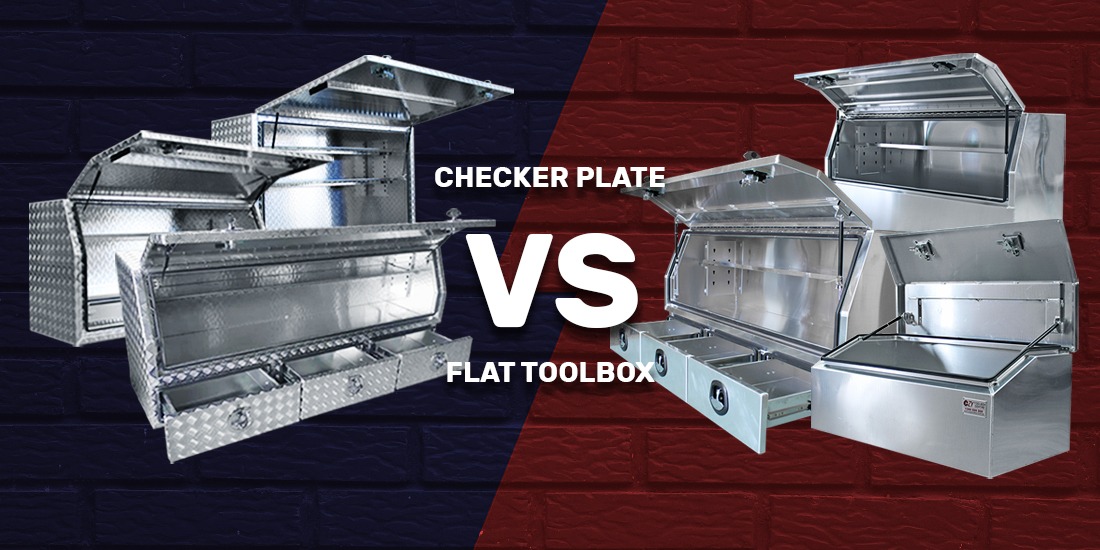Checker Plate Vs Flat Toolbox: What's the real difference?

When setting up your UTE, trailer, or truck for work or travel, choosing the right storage solution is key. Among the most popular toolbox types are the checker plate toolbox and the flat plate alternative. Both serve the same core purpose, safe and secure storage, but they offer different advantages when it comes to durability, appearance, and application.
Whether you're outfitting a dual-cab, a tray, or an under-tray configuration, understanding these differences helps you pick the right tool for your vehicle and workload.
What is a Checker Plate Toolbox?
A checker plate toolbox is constructed from aluminium checker plate, also known as tread plate or diamond plate. This material features a raised pattern of lines or diamonds that provide a rugged, non-slip grip, making it ideal for industrial and heavy-duty utes or trailers. Thanks to its tough exterior, it can easily withstand knocks, scratches, and even harsh outdoor conditions.
The added texture increases strength without significantly increasing weight, keeping your truck or tray functional without making it too heavy. Though these toolboxes are harder to polish or clean aluminum thoroughly, especially when grease or dust gets into the grooves, they offer a bold and rugged appearance that appeals to many tradespeople and off-roaders.
What is a Flat Plate Toolbox?
Flat plate toolboxes are made from smooth aluminium or stainless steel, providing a clean and modern finish that blends seamlessly with most vehicle colors. This makes them an excellent option for those who want a uniform look, especially on vehicles like a Ranger or custom work utes.
The smooth surface allows for a flawless powder coat finish, which not only looks sleek but is easier to keep clean. However, the absence of texture means any scratch or dent becomes more visible, especially if the lid or panels get pinged during loading or unloading. Despite that, the functionality remains top-notch, especially when the manufacturer uses high-grade material to enhance durability and strength while keeping it lighter than steel alternatives.
The Difference Between Checker Plate and Flat Plat Tool Box
First and foremost, what is the difference?
Checker plate is commonly used for flooring, cladding, toolboxes, ramps, and anything that requires an ultra-hard wearing material.
The checker plate design on the toolboxes at OZY TOOLBOX CENTRE is made of light-weight aluminium metal with a regular pattern of raised diamonds or lines on one-side. it is good to note that the diamond plate, tread plate, and checker plate are all the same and can be used interchangeably.
As you can imagine due to the raised design, the surfaces of these toolboxes are skid/slip-resistant. further to this these toolboxes are difficult to powder coat and maintain a consistent dark colour due to the raised surfaces.
The checker plate surface is more difficult to clean when compared to the flat toolboxes, due to the dirt building up around the raised sections. Aesthetically a silver checkered toolbox on a dark-colored ute/vehicle may not be very appealing.
On the other hand, the flat surface aluminium toolboxes are a smooth raw material and can be powder coated to look consistent with the look of the vehicle or surrounding.
However, if these toolboxes are pinged the risk of showing the dent is much higher than a textured toolbox. The most important aspect to consider regardless of the checkered or flat toolbox is the thickness of the aluminium.
You want it thick enough to be sturdy and secure but not that thick as to add unnecessary weight. at OZY TOOLBOX CENTRE we manufacture toolboxes to ensure lightweight and not compromise the sturdiness of the product, we have a range of thickness from 2mm to 3mm thickness.
So really you can choose either a checkered or Flat UTE canopy toolbox, both will do exactly the same job, it all boils down to personal preference.
Function Meets Style - Your Needs Decide
Whether you’re packing up for a job site or gearing up for a long-distance travel adventure, your toolbox should match both your functional and visual expectations. Flat plate toolboxes often shine when a polished, high-quality look is a priority, and they integrate well with color-matched vehicles.
On the other hand, checker plate toolboxes are built for tough conditions, where strength, grip, and resilience take the front seat. The application matters—whether it's under the cab, on the tray, or behind a dual cab setup. Choose the design that fits your daily routine, environment, and style, and you’ll always be satisfied with the outcome.
FAQs
Are there maintenance practices that differ based on the surface texture of a toolbox?
Yes. Checker plate toolboxes require more effort to keep clean because the raised patterns can trap grease, dirt, and dust. It's best to use a high-pressure wash or scrub around the raised diamonds. Flat plate toolboxes, especially powder-coated ones, are easier to clean aluminum surfaces and maintain a smooth finish.
Can the choice of toolbox material affect vehicle weight and fuel efficiency?
A heavier toolbox, especially one made from steel, will add more weight to your ute, affecting fuel efficiency. Opting for lighter materials like aluminium checker plate or flat aluminium designs can maintain durability without sacrificing fuel economy, especially important for utes used in long-haul travel.
How can choosing the right toolbox complement other accessories on your UTE or work vehicle?
The right toolbox can enhance both form and functionality. A sleek flat plate toolbox can be polished and powder-coated to match your custom paintwork or tray design, while a checker plate toolbox can add a rugged look that pairs perfectly with off-road wheels, bars, or roof racks. It’s about balancing storage, style, and durability to build the complete vehicle setup.
Author: Dean Peechiari Date Posted: 24 January 2021

